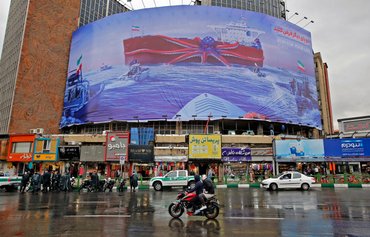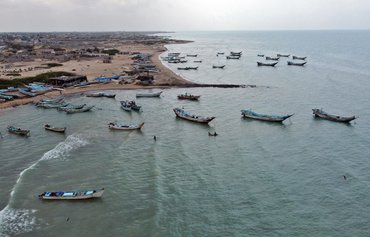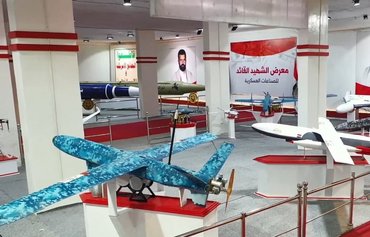Since at least 2016, Iran has increasingly engaged in irregular warfare via its proxies in the region in a bid to expand its influence while putting on a deceitful appearance of innocence.
It has consistently provided armed groups in Lebanon, Syria, Yemen and Iraq with drones and drone parts, which are used to enflame conflicts in the Middle East.
More recently, it has transferred drones to Russia for its unprovoked war in Ukraine.
In Yemen, cross-border Houthi attacks against predominantly civilian targets in Saudi Arabia doubled in number over the first nine months of 2021 compared to the same period in 2020, according to a December 2021 analysis by the Centre for Strategic and International Studies (CSIS).
![Iranian missiles are shown at Tehran's Islamic Revolution and Holy Defence museum in Tehran on September 21, 2019. [Atta Kenare/AFP]](/cnmi_di/images/2023/02/10/40724-iran-missiles-600_384.jpg)
Iranian missiles are shown at Tehran's Islamic Revolution and Holy Defence museum in Tehran on September 21, 2019. [Atta Kenare/AFP]
Weaponised Iranian drones have similarly been used against the United Arab Emirates (UAE).
Yemen also has become a key hub in the arms trade with eastern Africa, with weaponry sold by Yemen-based traders in Somalia, Sudan and elsewhere.
The Iran-backed Houthis have received weapons, technology, training and other assistance from Iran's Islamic Revolutionary Guard Corps-Quds Force (IRGC-QF) and the Lebanese Hizbullah, CSIS said.
Hizbullah itself has long served as a linchpin of Iran's drone programme, assembling drones at its bases with parts smuggled in from Iran via Syria.
Since 2004, the Islamic Republic has provided drones, drone components and designs to Hizbullah and trained its fighters, The Iran Primer said in a June 2021 report.
Between 2005 and 2012, Hizbullah obtained more advanced drones, expanding its unmanned aerial vehicle (UAV) operations after joining the conflict in Syria in 2012 in support of the regime of Bashar al-Assad.
By giving drones to Hizbullah, Iran wants to increase its capabilities "to serve the Iranian project in the region", said Lebanese Centre for Research and Consulting director Hassan Qutb.
This is evident in Syria, Iraq and Yemen, he told Al-Mashareq, where Hizbullah experts have been supervising the technological capabilities of Iranian proxies.
Indirect warfare
Iran's dependence on its proxies to wage attacks against its adversaries relieves it from engaging in a direct conflict -- one that it is certain to lose.
The United States and other Iranian adversaries, including Saudi Arabia, "enjoy a substantial advantage in conventional military power", said the CSIS in its analysis.
"Iran's aging inventory of conventional ground, air and maritime capabilities lags well behind the United States and some US partners in the region," it said.
Iranian-linked groups resort to stand-off attacks that are harder to defend against, and that target crucial facilities, such as oil facilities in Saudi Arabia, thus disrupting the energy sector in that country.
The Houthis targeted Yemen's ports and oil vessels in a string of attacks last October and November.
These attacks would harm only the Yemeni people by worsening fuel shortages, said Steven Fagin, US Ambassador to Yemen, on November 21, calling on the Iran-backed group to halt its threats to international maritime commerce.
Meanwhile, Iranian provocations and acts of piracy continue to threaten oil vessels in the Strait of Hormuz, one of the world's busiest waterways through which a fifth of world oil output passes.
Weapons interdictions
In recent years, the United States and its partners have interdicted dozens of shipments of illegal weapons along routes historically used to traffic weapons unlawfully from Iran to Yemen.
In January, elite French forces, with support from the US military, seized a massive shipment of Iranian arms destined for the Houthis in the Gulf of Oman.
The maritime interdiction took place on January 15, US Central Command (CENTCOM) said on February 2.
"More than 3,000 assault rifles, 578,000 rounds of ammunition and 23 advanced anti-tank guided missiles were recovered," it said.
"The seizure is one of four significant illicit cargo interdictions over the past two months that have prevented more than 5,000 weapons and 1.6 million rounds of ammunition from reaching Yemen," CENTCOM said.
On January 6, the US Navy intercepted a fishing vessel in the Gulf of Oman as it attempted to smuggle more than 2,100 assault rifles along a maritime route from Iran to Yemen.
In December, US naval forces seized explosive precursor materials, rocket fuses and propellant being smuggled on a fishing trawler from Iran to Yemen.
The cargo included 140 tonnes of urea fertiliser, 70 tonnes of ammonium perchlorate and 50 tonnes of ammunition rounds.
And in November, the US Navy said it had scuttled a boat transporting "explosive materials" from Iran to supply the Houthis, with enough power to fuel a dozen ballistic missiles.
On January 23, Yemeni security forces intercepted a shipment of 100 UAV engines bound for the Houthis, according to media reports.
Yemeni officials said security forces seized the drone parts while inspecting a truck purportedly loaded with clothing at a crossing point in al-Mahra province, Asharq al-Awsat reported.
The shipment was halted at the Omani border, Consultation and Reconciliation Commission deputy head Abdulmalik al-Mekhlafi said on Twitter.
"How many people could these drones have killed? How many [drones] have been smuggled over the past eight years?" he asked.
"These types of interdictions are critical for regional security and stability," said CENTCOM spokesman Col. Joe Buccino.
Smuggling by air
Other than illicit shipments by sea and by land, Iran has ferried weapons to its proxies in the region, and most recently to the Kremlin for its war in Ukraine, via its fleet of civil airliners.
On February 3, the United States designated eight Iranian individuals in leadership roles at Paravar Pars, a previously sanctioned Iranian firm that produces UAVs for the IRGC's Aerospace Force.
"Iranian UAVs are being transferred to Russia for use in its brutal and unprovoked war against Ukraine," the US Department of State said in a statement.
Iran has been using Mahan Air to transport weapons, military equipment and foreign fighters to various conflict zones in the Middle East in support of its expansionist agenda, analysts say.
Some reports describe the airline as the main carrier for the IRGC and the Quds Force, said Middle East Centre for Regional and Strategic Studies researcher Fathi al-Sayyed, who specialises in Iranian affairs.
"Unit 190 of the IRGC specialises in the smuggling of weapons to other countries like Sudan, Yemen, Syria and Lebanon, and this unit uses all available means to transport cargo by land, sea and air through Mahan Air," he said.
"A similar unit, known as Unit 198, took charge of handling air transport flights to conflict zones and the transport of mainly IRGC officers in complete secrecy," he said. "This second unit often handles the protection and insurance of operations carried out by Unit 190."

![People demonstrate outside the Iranian embassy in Ukraine on October 17 in Kyiv, after the city was hit by swarms of kamikaze drones sold by Iran to Russia, leaving at least three dead. [Sergei Chuzavkov/AFP]](/cnmi_di/images/2023/02/10/40723-iran-terrorism-600_384.jpg)






